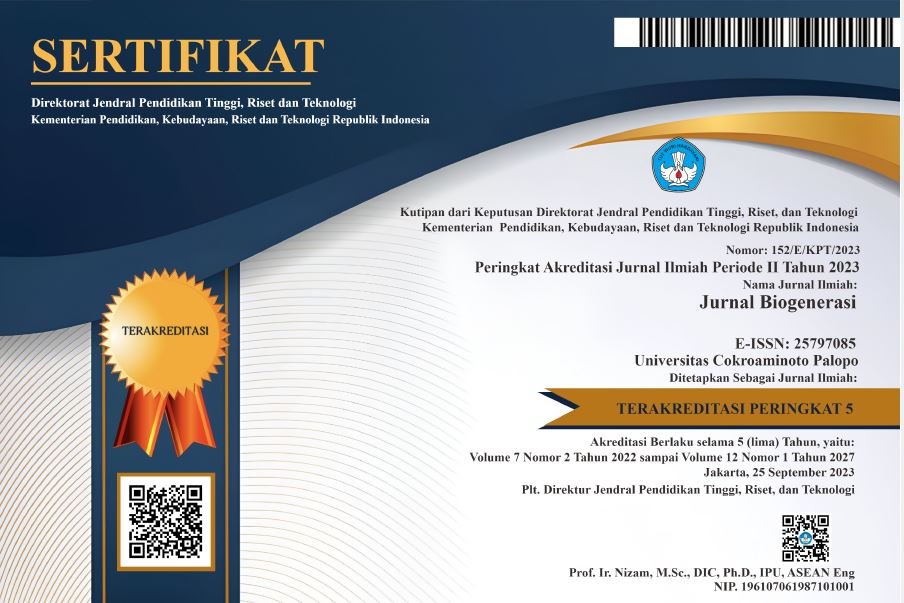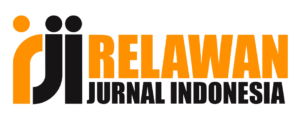ANALISIS GAYA BELAJAR PESERTA DIDIK KELAS X PADA MATERI PENCEMARAN AIR DENGAN MODEL PROJECT BASED LEARNING (PjBL)
DOI:
https://doi.org/10.30605/biogenerasi.v10i2.5675Keywords:
Learning styles, Learning outcomes, PjBL, Water PollutionAbstract
Identifying learners' learning styles is a major part of supporting better learning. Knowing the learning style of students is very important to develop meaningful learning. This study aims to analyze the learning style of class X students on water pollution material through the application of the Project Based Learning (PjBL) model. This research was conducted at SMA Karya Dharma Veteran Sambi, Boyolali. The research method used was descriptive qualitative with data collection techniques in the form of questionnaires, interviews, and observations. Data analysis was carried out by percentage analysis and interview analysis techniques using Miles and Huberman techniques, including data collection, data reduction, data presentation and conclusion drawing. The results showed that students have different learning style tendencies, with visual learning styles dominating. The application of the PjBL model in learning water pollution material has a positive impact on improving student learning outcomes, as evidenced by the N-gain result of 0.55 in the moderate category. The PjBL learning model was able to accommodate the learning style needs of students by combining discussion, lecture, and practicum methods.
Downloads
References
Aqilla, Aulia Ryza et al. 2023. “Pengaruh Sampah Plastik Dalam Pencemaran Air.” GJMI: Gudang Jurnal Multidisiplin Ilmu 1(6): 275–80.
Aroya, Yovanka, Pandji Winata Nurikhwan, and Oski Illiandri. 2020. “Hubungan Gaya Belajar Terhadap Nilai Ujian Blok Mahasiswa Pskps Fkik Ulm Angkatan 2020.” HOMEOSTASIS: Jurnal Mahasiswa Pendidikan Dokter 7(1): 207–18.
Banila, Lidya, Hana Lestari, and Ridwan Siskandar. 2021. “Penerapan BlendedLearning Dengan Pendekatan STEM Untuk Meningkatkan Kemampuan Literasi Sains Siswa Pada Pembelajaran Biologi Di Masa Pandemi Covid-19.” Journal of Biology Learning 3: 25–33.
Cholifah, Tety Nur. 2018. “ANALISIS GAYA BELAJAR SISWA UNTUK PENINGKATAN KUALITAS PEMBELAJARAN.” Indonesian Journal of Natural Science Education (IJNSE) 1(2): 65–74. http://jom.untidar.ac.id/index.php/ijnse/article/view/273.
Faslah, Roni. 2011. “PEMANFAATAN INTERNET DALAM PENGEMBANGAN KONSEP IPS DAN IMPLIKASINYA TERHADAP PEMBELAJARAN BERMAKNA.” Econosains Jurnal Online Ekonomi dan Pendidikan 9(2): 167–70. http://journal.unj.ac.id/unj/index.php/econosains/article/view/624.
Fauzi, Rahmat, Ali Usman, Nanik Nur Hayati, and Muhammad Dimas Nasihudin. 2023. “Pengelompokan Gaya Belajar Secara Homogen Dalam Mendukung Pembelajaran Diferensiasi Proses Siswa.” Jurnal Teknologi Pendidikan 1(2): 9. https://edu.pubmedia.id/index.php/jtp/article/view/77.
Hake, Richard. 2014. “Relationship of Individual Student Normalized Learning Gains in Mechanics with Gender , High-School Physics , and Pretest Scores on Mathematics and Relationship of Individual Student Normalized Learning Gains in Mechanics with Gender , High-School Physics.” (January 2002).
Hanifah, Laili Nur, and Eko Retno Mulyaningrum. 2021. “ANALISIS GAYA BELAJAR SISWA KELAS X TERHADAP HASIL BELAJAR PADA MATERI PROTISTA DI SMA NEGERI 1 GODONG.” Jurnal Ilmiah Edukasia 1(1): 112–28. http://journal.upgris.ac.id/index.php/JIE/article/view/7970.
Hasanah, Risa Zakiatul. 2021. Gaya Belajar (Learning Style). 1st ed. Malang: CV. Literasi Nusantara Abadi.
Hatika, Rindi Ganesha, and Pariang Sonang Siregar. 2016. “EFEKTIVITAS METODE PRAKTIKUM TERHADAP HASIL BELAJAR PSIKOMOTORIK FISIKA SISWA SMA NEGERI 3 RAMBAH HILIR Rindi Genesa Hatika 1) Pariang Sonang Siregar 2) 2.” Journal ilmiah Edu Reseacrh 5(1): 15–18.
Himmah, Fakinatul Izzun, and Nursiwi Nugraheni. 2023. “Analisis Gaya Belajar Siswa Untuk Pembelajaran Berdiferensiasi Analysis of Student Learning Styles for Differentiated Learning.” Jurnal Riset dan Pendidikan Dasar 4(1): 31–39.
Mar’ah, Anisatul. 2015. WALISONGO Institutional Repository “Gaya Belajar Dan Faktor Pengaruhnya Terhadap Pencapaian Prestasi Belajar IPA Terpadu Siswa Kelas VIII MTS Sultan Fatah Gaji Guntur Demak Tahun Pelajaran 2015/2016.” Universitas Islam Negeri Walisongo. http://eprints.walisongo.ac.id/5170/1/113811022.pdf.
Muthmainnah, Rifaatul et al. 2023. “Pelatihan Penggunaan Alat Laboratorium Dan Pengenalan Praktikum Biologi Sederhana Bagi Guru Biologi Dan Siswa.” Sasambo: Jurnal Abdimas (Journal of Community Service) 5(2): 382–91. http://journal-center.litpam.com/index.php/.
Nabila, Marisa Christina Tapilouw, and Sucahyo. 2023. “Biology Learning Innovation in the Water Pollution Sub Material Based on Sustainable Development Goals ( SDGs ) Using the Problem-Based Learning A . Introduction B . Material and Method.” BIO-INOVED : Jurnal Biologi-Inovasi Pendidikan 5(3): 297–306.
Nadar, Monica et al. 2020. “Effectiveness of Structured Teaching Programme on Hazards of Water Pollution.” Indian Journal of Forensic Medicine & Toxicology 14(4): 3674–81. http://medicopublication.com/index.php/ijfmt/article/view/12201.
Pardede, Kristin, Marzuki Ahmad, and Muhammad Syahril Harahap. 2021. “HASIL BELAJAR MATEMATIKA SISWA SELAMA PANDEMI COVID-19.” JURNAL MathEdu (Mathematic Education Journal) 4(2): 243–52.
Piaget, Jean. 2002. Tingkat Perkembangan Kognitif. Jakarta: Gramedia.
De Potter, Bobbi, and Mike Hernacki. 2007. Quantum Learning. Diterjemahkan Oleh Alwiyah Adurrahman. Bandung: Kaifa PT. Mizan Pustaka.
Putra, Thofan Rahardika. 2018. “Pengembangan Media Pembelejaran Animasi Berbasis Macromedia Flash Pada Materi Trigonometri.” Universitas Islam Raden Intan.
Rahmawati, Evie et al. 2021. “IDENTIFIKASI MOTIVASI BELAJAR DAN GAYA BELAJAR PESERTA DIDIK SEKOLAH MENENGAH ATAS.” Didaktika: Jurnal Kependidikan 15(2): 116–29.
Ratnawati, Kadek. 2020. “Penerapan Model Pembelajaran Berbasis Proyek Pada Pembuatan Strip Komik Untuk Meningkatkan Kemampuan Menulis Bahasa Inggris.” Indonesian Journal of Educational Development 1(3): 481–95.
Sholekah, Anis Wahdati. 2020. “Peningkatan Motivasi Dan Hasil Belajar IPA Materi Pencemaran Lingkungan Melalui Model PjBL Siswa Kelas VII SMPN 9 Salatiga.” JURNAL PENDIDIKAN MIPA 10(1): 16–22. http://ejournal.tsb.ac.id/index.php/jpm/article/view/260.
Supit, Deisye, Melianti Melianti, Elizabeth Meiske Maythy Lasut, and Noldin Jerry Tumbel. 2023. “Gaya Belajar Visual, Auditori, Kinestetik Terhadap Hasil Belajar Siswa.” Journal on Education 5(3): 6994–7003. https://jonedu.org/index.php/joe/article/view/1487.
Syaifuddin, Ahmad. 2024. “Efektifitas Socrative Untuk Assesmen Diagnostik Gaya Belajar Siswa Madrasah Ibtidaiyah.” Edu Journal : Innovation in Learning and Education 02(01): 15–24.
Ulfah, and Opan Arifudin. 2021. “Pengaruh Aspek Kognitif, Afektif, Dan Psikomotor Terhadap Hasil Belajar Peserta Didik.” Jurnal Al-Amar (JAA) 2(1): 1–9.
Wakhid, Burhannudin Nur, Cucuk Wawan Budiyanto, and Yuliyani Siyamtiningtyas. 2024. “Analysis of Project-Based Learning Model on the Learning Styles of PPLG SMK Negeri Students in Surakarta.” IJIE (Indonesian Journal of Informatics Education) 7(2): 142. https://jurnal.uns.ac.id/ijie/article/view/81689.
Downloads
Published
How to Cite
Issue
Section
License
In submitting the manuscript to the journal, the authors certify that:
- They are authorized by their co-authors to enter into these arrangements.
- The work described has not been formally published before, except in the form of an abstract or as part of a published lecture, review, thesis, or overlay journal.
- That it is not under consideration for publication elsewhere,
- That its publication has been approved by all the author(s) and by the responsible authorities – tacitly or explicitly – of the institutes where the work has been carried out.
- They secure the right to reproduce any material that has already been published or copyrighted elsewhere.
- They agree to the following license and copyright agreement.
License and Copyright Agreement
Authors who publish with this journal agree to the following terms:
- Authors retain copyright and grant the journal right of first publication with the work simultaneously licensed under Creative Commons Attribution License (CC BY 4.0) that allows others to share the work with an acknowledgment of the work's authorship and initial publication in this journal.
- Authors are able to enter into separate, additional contractual arrangements for the non-exclusive distribution of the journal's published version of the work (e.g., post it to an institutional repository or publish it in a book), with an acknowledgment of its initial publication in this journal.
- Authors are permitted and encouraged to post their work online (e.g., in institutional repositories or on their website) prior to and during the submission process, as it can lead to productive exchanges, as well as earlier and greater citation of published work.


.png)

